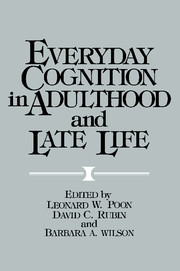Book contents
- Frontmatter
- Contents
- List of contributors
- Preface
- Part I Adult cognitive abilities in the laboratory and in real-life settings: Basic theoretical and methodological issues
- Part IA Systematic approaches to laboratory and real-world research
- Part IB Combining laboratory and real-world research
- Part II Cognition in adulthood and late life: Findings in real-life settings
- Part IIA Everyday cognitive abilities
- Part IIB Concomitant influences
- 21 Motivation and aging
- 22 Questionnaire research on metamemory and aging: Issues of structure and function
- 23 The importance of awareness in memory aging
- 24 Age and expertise: Responding to Talland's challenge
- 25 World-knowledge systems
- 26 Comments on aging memory and its everyday operations
- Part III Cognitive enhancement and aging: Clinical and educational applications
- Part IIIA Issues and perspectives
- Part IIIB Enhancement approaches
- Part IIIC Designing programs for cognitive rehabilitation
- Subject index
- Author index
22 - Questionnaire research on metamemory and aging: Issues of structure and function
Published online by Cambridge University Press: 05 October 2013
- Frontmatter
- Contents
- List of contributors
- Preface
- Part I Adult cognitive abilities in the laboratory and in real-life settings: Basic theoretical and methodological issues
- Part IA Systematic approaches to laboratory and real-world research
- Part IB Combining laboratory and real-world research
- Part II Cognition in adulthood and late life: Findings in real-life settings
- Part IIA Everyday cognitive abilities
- Part IIB Concomitant influences
- 21 Motivation and aging
- 22 Questionnaire research on metamemory and aging: Issues of structure and function
- 23 The importance of awareness in memory aging
- 24 Age and expertise: Responding to Talland's challenge
- 25 World-knowledge systems
- 26 Comments on aging memory and its everyday operations
- Part III Cognitive enhancement and aging: Clinical and educational applications
- Part IIIA Issues and perspectives
- Part IIIB Enhancement approaches
- Part IIIC Designing programs for cognitive rehabilitation
- Subject index
- Author index
Summary
The title of this chapter is so commodious that it may be useful to begin by tidying up the domain of interest. First, there are two chapters in this section devoted to metamemory and aging; the other is Chapter 23 by John Cavanaugh. The field has been divided in a convenient way, and perhaps a theoretically and methodologically meaningful way. Specifically, Cavanaugh presents a discussion of the literature on metamemory and aging, where “metamemory” is operationally defined with any of multiple experimental (often on-line laboratory) tasks. I, on the other hand, have been charged with introducing the topic in a general (and certainly all too brief) manner and focusing attention on the metamemory and aging literature, where “metamemory” is indicated by verbal-report data (especially questionnaire data).
There is one further delineation in my topic I should note. Within the realm of verbal-report memory data, there are several domains, each of which is at least indirectly relevant to the issue at hand, but only one of which is immediately pertinent. These topics are summarized in Table 22.1. With the additional criterion of the consideration of developmental (especially aging) questions, this delineation follows closely that of Herrmann (1984). For the most part, I shall not address topic 1 (semantic-memory questionnaires), even those in which developmental (or aging) issues are paramount (Botwinick & Storandt, 1980; Erber, 1981; Perlmutter, Metzger, Miller, & Nezworski, 1980; Poon, Fozard, Paulshock, & Thomas, 1979; Riegel, 1973), and even though there is clear evidence that these techniques, which are verifiable against established facts, can represent valid ways of investigating memory (Herrmann, 1984).
- Type
- Chapter
- Information
- Everyday Cognition in Adulthood and Late Life , pp. 394 - 415Publisher: Cambridge University PressPrint publication year: 1989
- 38
- Cited by



